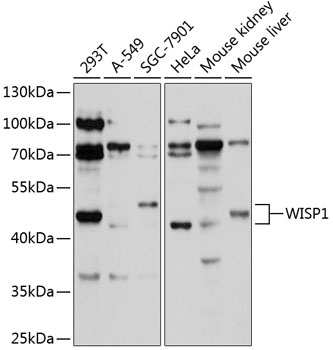| バックグラウンド: | This gene encodes a member of the WNT1 inducible signaling pathway (WISP) protein subfamily, which belongs to the connective tissue growth factor (CTGF) family. WNT1 is a member of a family of cysteine-rich, glycosylated signaling proteins that mediate diverse developmental processes. The CTGF family members are characterized by four conserved cysteine-rich domains: insulin-like growth factor-binding domain, von Willebrand factor type C module, thrombospondin domain and C-terminal cystine knot-like domain. This gene may be downstream in the WNT1 signaling pathway that is relevant to malignant transformation. It is expressed at a high level in fibroblast cells, and overexpressed in colon tumors. The encoded protein binds to decorin and biglycan, two members of a family of small leucine-rich proteoglycans present in the extracellular matrix of connective tissue, and possibly prevents the inhibitory activity of decorin and biglycan in tumor cell proliferation. It also attenuates p53-mediated apoptosis in response to DNA damage through activation of the Akt kinase. It is 83% identical to the mouse protein at the amino acid level. Multiple alternatively spliced transcript variants have been identified. |
| UniProt Protein Function: | Downstream regulator in the Wnt/Frizzled-signaling pathway. Associated with cell survival. Attenuates p53-mediated apoptosis in response to DNA damage through activation of AKT kinase. Up-regulates the anti-apoptotic Bcl-X(L) protein. Adheres to skin and melanoma fibroblasts. In vitro binding to skin fibroblasts occurs through the proteoglycans, decorin and biglycan. |
| NCBI Summary: | This gene encodes a member of the WNT1 inducible signaling pathway (WISP) protein subfamily, which belongs to the connective tissue growth factor (CTGF) family. WNT1 is a member of a family of cysteine-rich, glycosylated signaling proteins that mediate diverse developmental processes. The CTGF family members are characterized by four conserved cysteine-rich domains: insulin-like growth factor-binding domain, von Willebrand factor type C module, thrombospondin domain and C-terminal cystine knot-like domain. This gene may be downstream in the WNT1 signaling pathway that is relevant to malignant transformation. It is expressed at a high level in fibroblast cells, and overexpressed in colon tumors. The encoded protein binds to decorin and biglycan, two members of a family of small leucine-rich proteoglycans present in the extracellular matrix of connective tissue, and possibly prevents the inhibitory activity of decorin and biglycan in tumor cell proliferation. It also attenuates p53-mediated apoptosis in response to DNA damage through activation of the Akt kinase. It is 83% identical to the mouse protein at the amino acid level. Multiple alternatively spliced transcript variants have been identified. [provided by RefSeq, Mar 2011] |
| UniProt Code: | O95388 |
| NCBI GenInfo Identifier: | 34098393 |
| NCBI Gene ID: | 8840 |
| NCBI Accession: | O95388.1 |
| UniProt Secondary Accession: | O95388,Q5JBS6, Q5JBS7, Q5JBS8, Q9HCS3, A8KAG6, E7EMM5 |
| UniProt Related Accession: | O95388 |
| Molecular Weight: | 21,550 Da |
| NCBI Full Name: | WNT1-inducible-signaling pathway protein 1 |
| NCBI Synonym Full Names: | WNT1 inducible signaling pathway protein 1 |
| NCBI Official Symbol: | WISP1 |
| NCBI Official Synonym Symbols: | CCN4; WISP1c; WISP1i; WISP1tc |
| NCBI Protein Information: | WNT1-inducible-signaling pathway protein 1 |
| UniProt Protein Name: | WNT1-inducible-signaling pathway protein 1 |
| UniProt Synonym Protein Names: | CCN family member 4; Wnt-1-induced secreted protein |
| Protein Family: | WNT1-inducible-signaling pathway protein |
| UniProt Gene Name: | WISP1 |
| UniProt Entry Name: | WISP1_HUMAN |


